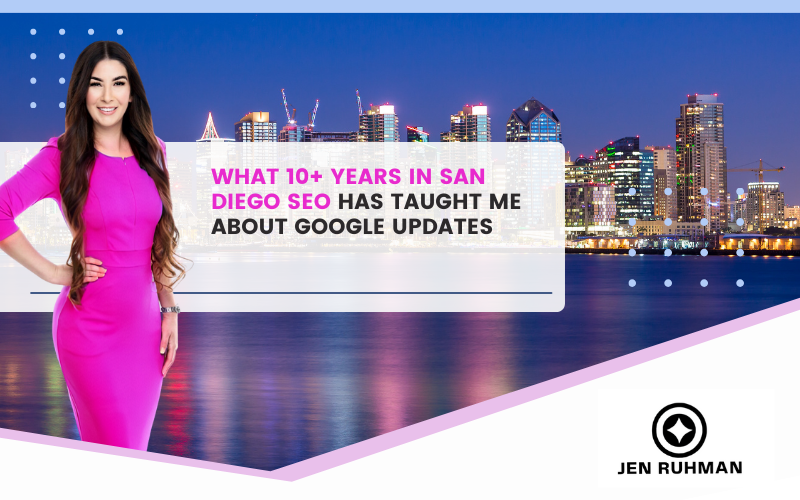What 10+ Years in San Diego SEO Has Taught Me About Google Updates
What should you do during a Google update?
Stabilize your site: document metrics, avoid panic edits, and review content quality, topical depth, and technical health. Strengthen E-E-A-T signals and make your answers clearer and faster to find.
What should you avoid?
Don’t rip out pages, buy links, or spin content. Avoid major redesigns without diagnostics. Don’t chase short-term tricks.
How long should you wait before acting?
Establish a 2–4 week observation window after volatility settles. Then make targeted, measured improvements you can attribute and track.
Who I Am (Why Listen)
I’m Jen Ruhman, owner of a boutique SEO company San Diego. For more than a decade, I’ve helped local brands—from clinics and med spas to movers and professional services—navigate wave after wave of Google changes. My approach is practical: plan, test, measure, improve. And yes—Call/text me: (619) 719-1315 if you want help applying this playbook to your business.
My San Diego Roots & Client Mix
Working with San Diego businesses means balancing local intent, seasonality, and neighborhood-specific competition (Point Loma ≠ La Jolla ≠ Encinitas). I’ve seen the same updates affect industries differently based on search intent and local signals.
Approach Grounded in E-E-A-T
Real expertise, experience, author transparency, and trustworthy sources win long term. Google’s systems change, but users still want accurate, helpful, first-hand guidance.
What Google Updates Really Are (Plain English)
Core Updates vs. Smaller Updates
Core updates are broad quality recalibrations. Smaller updates target spam, reviews, or very specific issues. Think of it like regular tune-ups vs. a full engine remap.
Why Volatility Happens
Google is trying to surface the most helpful, trustworthy results. If your competitors get better at answering questions or establishing trust, rankings shift—even if you didn’t “do anything wrong.”
The Ground Rules I Follow in Every Update
User-First Content and Clarity
I make content easy to skim and complete: clear intros, direct answers, step-by-steps, and takeaways. I add quick summaries and FAQs to match how people (and AI systems) digest information.
Topical Depth Over “Thin” Pages
A single thin post won’t win. Build topic clusters that cover a subject from definitions and symptoms to pricing, process, and local specifics.
Technical Basics That Never Go Out of Style
Fast loads, clean internal links, consistent URL logic, non-bloated code, and descriptive titles/meta. Old-school? Yes. Reliable? Absolutely.
How Updates Hit Local Businesses Specifically
Proximity, Prominence, and Relevance
Local packs and maps respond heavily to where the user is, how well-known your brand is, and how relevant your page content is to the query. Proximity matters, but great on-page relevance can still pull in discovery searches.
GBP Optimization & Review Quality
Your Google Business Profile (GBP) is not “set it and forget it.” Categories, services, photos, and detailed reviews all influence real users and, indirectly, rankings. Quality and recency matter.
Real San Diego Stories (Anonymized Case Snapshots)
The Med Spa with a Content Gap
A med spa saw dips during a core update. Diagnosis showed “look-good” pages, but light educational depth. We built treatment explainers, before/after guidance, candid risk sections, and pricing context. Rankings stabilized, then improved.
The Moving Company with Internal-Link Wins
A mover’s blog was active but disconnected. After mapping internal links to service pages and adding location-intent headers, traffic to money pages rose—and calls followed.
The Clinic that Embraced E-E-A-T
A clinic lacked author identity and citations. We added doctor bios, credentials, medically-reviewed notes, and references. Their helpful content plus trust signals carried them through updates.
Content Strategy That Survives Updates
Topic Clusters & Intent Mapping
Group content by intent—informational, commercial, local, or navigational. For each cluster, assign a “hub” page and build spokes that answer specific sub-questions.
Content Refresh Cadence
Stale content loses. I calendar reviews every 6–12 months. Refresh stats, add FAQs, tighten intros, include fresh internal links.
Helpful Formatting for AI Overviews
Use short, fact-based summaries, bullet takeaways, checklists, and clear headings. This improves user experience and aligns with how AI summarizes pages.
Technical Habits That Shield You
Crawlability, Page Speed, CWV
If search engines struggle to fetch or render your pages—or users bounce on slow loads—quality signals can’t save you. Optimize CWV, compress media, lazy-load, and keep a tidy DOM.
Schema & Structured Data That Clarify Meaning
Article, FAQ, LocalBusiness, Product/Service, and Review schema help search engines correctly understand your page and its purpose.
Link Building That Ages Well
Digital PR, Local Citations, and Relevance
I prioritize relevance over raw domain metrics. Local news mentions, industry associations, quality directories, and genuine partnerships compound over time.
What to Avoid (PBNs, Spam)
Spammy links might spike metrics briefly but often backfire during or after updates. If you wouldn’t be proud to show the link to a customer, don’t build it.
Optimizing for AI Search & SGE
Direct Answers, Summaries, and Scannability
Place “answer blocks” near the top. Include definitions, quick steps, and short verdicts. Make it simple for AI systems to quote or summarize your content accurately.
Entities, FAQs, How-Tos, and Schema
Help search engines connect the dots: who you are, what you offer, where you serve, and why users can trust you. Rich FAQs and how-tos capture long-tail questions.
Local SEO Levers During Turbulence
GBP Categories, Services, and Photos
Keep categories precise, list services with real descriptions, and post updated photos that reflect your current brand and space.
Review Velocity & Response Quality
Encourage steady, authentic reviews. Respond with empathy and detail. This is reputation management and user trust—both matter during quality recalibrations.
How I Monitor, Diagnose, and Respond
Baselines, Annotations, and Isolating Variables
I maintain dashboards for baseline metrics and annotate changes (content updates, technical fixes, campaigns). When rankings shift, we can trace likely causes.
When to Pivot vs. When to Wait
If the drop aligns with a known update, wait 2–4 weeks to confirm the pattern. Then make measured improvements—content depth, internal links, schema, UX—not knee-jerk overhauls.
Hiring the Right Partner (Avoid Contract Traps)
Red Flags in SEO Contracts
Beware of rigid long-term contracts with vague deliverables, hidden link schemes, or promises of guaranteed rankings.
What a Healthy Partnership Looks Like
Transparent scopes, clear KPIs, real content plans, technical auditing, ethical link strategy, and monthly reporting tied to business outcomes.
Ready to Stay Ahead of Google Updates
If you want a steady, proven approach through updates—without panic pivots—work with a trusted SEO expert in San Diego who’s navigated these waters for years. I’ll audit, stabilize, and grow your visibility with a durable strategy built for both searchers and search engines.
Call/text me: (619) 719-1315 or contact my boutique SEO company San Diego today.
After a decade-plus of updates, one truth remains: Google rewards sites that help people get answers quickly, confidently, and safely. Focus on expertise, experience, clarity, and trust. Keep your technical foundation tight, your content fresh and complete, and your local signals consistent. Do that—and updates become opportunities, not emergencies.
FAQs
1) How do I know if a drop is from a Google update or my own changes?
Check your annotations and release notes. If a dip aligns with a confirmed update window and you made no big changes, it’s likely update-related.
2) Should I rewrite all my content after a core update?
No. Start with diagnostics. Improve the pages closest to the affected queries and user intent. Refresh, don’t raze.
3) Do backlinks still matter after all these quality updates?
Yes—quality, relevance, and legitimacy matter more than ever. Think PR and partnerships, not link farms.
4) What’s the fastest win during volatility?
Clarify the page’s purpose. Tighten titles and intros, add answer blocks and FAQs, improve internal linking to your key service pages.
5) How often should I revisit older posts?
Plan a content refresh cycle every 6–12 months or sooner for high-value pages in competitive spaces.



